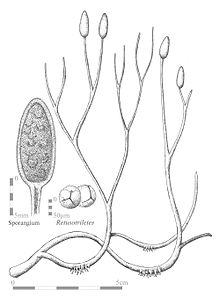
Back Aglaophyton major Catalan Aglaophyton major German Aglaophyton major Spanish زیباگیاه Persian Aglaophyton Finnish Aglaophyton ID Aglaophyton Italian Aglaophyton major Dutch Aglaophyton NB Aglaofiton Polish
| Aglaophyton Temporal range:
| |
|---|---|

| |
| Reconstruction of the sporophyte of Aglaophyton, illustrating bifurcating axes with terminal sporangia, and rhizoids. Insets show a cross-section of a sporangium and the probable spores. | |
| Scientific classification | |
| Kingdom: | Plantae |
| Clade: | Polysporangiophytes |
| Genus: | †Aglaophyton D.S.Edwards 1986[1] |
| Species | |
| |
| Synonyms | |
| |
Aglaophyton major (or more correctly Aglaophyton majus[2]) was the sporophyte generation of a diplohaplontic, pre-vascular, axial, free-sporing land plant of the Lower Devonian (Pragian stage, around 410 million years ago). It had anatomical features intermediate between those of the bryophytes and vascular plants or tracheophytes.
A. major was first described by Kidston and Lang in 1920 as the new species Rhynia major.[3] The species is known only from the Rhynie chert in Aberdeenshire, Scotland, where it grew in the vicinity of a silica-rich hot spring, together with a number of associated vascular plants such as a smaller species Rhynia gwynne-vaughanii which may be interpreted as a representative of the ancestors of modern vascular plants and Asteroxylon mackei, which was an ancestor of modern clubmosses (Lycopsida).
- ^ a b Cite error: The named reference
Edwards_1986was invoked but never defined (see the help page). - ^ Strictly the name should have been Aglaophyton majus, as -phyton is neuter and the neuter of Latin comparative adjectives ends in -us. Since February 2018, authors writing on the Rhynie chert have begun using the more correct form. See Wellman, Charles H. (2018), "Palaeoecology and palaeophytogeography of the Rhynie chert plants: Further evidence from integrated analysis of in situ and dispersed spores", Philosophical Transactions of the Royal Society B, 373 (1739): 20160491, doi:10.1098/rstb.2016.0491, PMC 5745327, PMID 29254956 and other papers in the same issue of that journal.
- ^ Cite error: The named reference
KidstonLang1920was invoked but never defined (see the help page).
© MMXXIII Rich X Search. We shall prevail. All rights reserved. Rich X Search